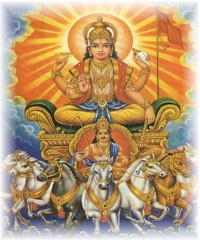 |
 |
|
| RATH SAPTAMI |
|
|
|
|
|
| On the seventh day of the bright
half of the Magh month the Sun is worshipped. The sun is imagined to be a
chariot drawn by seven horses, which represent the seven colours of the
rainbow. The charioteer, Arun, has his feet deformed. Arunoday means the dawn.
On this day some people go to take bath in the river before dawn carrying a
lamp on their head. Then in the courtyard in front of the house the sun is
worshipped. A picture of the chariot and the seven horses is drawn on the
ground. On the four sides “rangoli” is made (designs made with powders) and in
the centre cow dung is burnt. Then on the stove milk is boiled in earthen
vessels while facing the sun. When the milk boils it is believed it reaches the
sun.
|
 |
|
|
| Then an offering of “khir” made of
wheat is shown to the sun. In the “sup” (basket for sifting corn) twelve heaps
of grain are offered to the sun, the number corresponding to the twelve
constellations through which the sun goes. Grain is offered to the
brahmins.Some people show their respect to the sun by bowing twelve times every
day to the sun, repeating every time one of the twelve names of the sun. These
twelve names are: Mitra, Ravi, Surya, Ahanu, Khag, Pushan, Hirnyagarbha,
Marichi, Aditya, Savita, Arka, and Bhaskar. On this day a new season begins,
the sun sitting on his chariot sets out on his journey. |
|
| In the country of Kamboj there was a king
named Yashovarma. He was a religious minded ruler, arid happiness prevailed in
his kingdom. But the king had become old and had no children. He prayed to God
to give him a son. Finally God heard his prayer and the king got a son. But the
son was very sickly. All remedies were tried but the boy would not be cured. |
|
| One day a Muni named Vinit came to the palace.
He was a very learned Muni and knew the three times (“tricalgnani”), which
means that he knew the past, the present, and the future. So the king asked the
Muni when his son would get alright. Muni Vinit remained with his eyes closed
for a while. Then he said to the king, “Your son is sick
because in his previous life he was very rich, but never gave any alms and used
his wealth for himself only.” |
|
King Yashovarma asked, “If
he was a sinner, how is it that he was born the son of a king?”
Muni Vinit replied, “Yes, he was a sinner in his previous
life. But once with his eyes he saw the “puja” (worship) of Rath Saptami. With
this he acquired the merit needed to be born of a royal family.”
“So, will not his sickness disappear by a similar act of
merit?” King Yashovarma eagerly asked.
“Yes, make him observe the vow of ‘Rath Saptami’ and his
sickness will completely disappear.”
Then Mimi Vinit gave the king information about Rath Saptami
and by the merit of this vow the King’s son was liberated from his disease. |
|
The Gayatri Mantra
From ancient times men have attributed divinity to the sun.
For the “munj” (thread) ceremony the boy is made to stand facing the sun, and
the priest makes the following prayer, “Oh Sun, this is your student. Protect
him, and give him a long life.” After the “munj” ceremony every day in the
evening the Gayatri mantra must be recited. This mantra is given great
importance:
“God is the mover of this world. The shining brilliance of
God is the most exalted and the most difficult to describe. This brilliance is
liked by everybody. We meditate upon such brilliance. We bring it to our mind.
May this God, who is the sun, inspire our intellect and our devotional
medita-tion and may the recitation of this gayatri illumine our intellect.” |
|
|
|
|
|
|
|
 |
 |
|
 |
 |
|
 |
 |
|